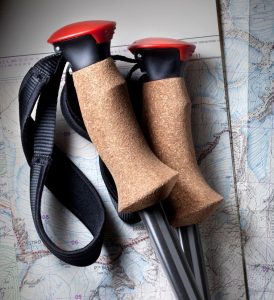
Are you tired of stumbling around on your hikes like a drunken penguin? Do you want to feel like a majestic mountain goat, gracefully navigating through the wilderness? Well, my friend, it’s time to embrace the power of the trekking pole. Not only will it make you look like a seasoned hiker, but it also has a plethora of benefits that will have you wondering how you ever survived without one. So, grab your poles and let’s take a walk on the wild side!
Benefits of using trekking poles
Improved Balance and Stability
One of the most obvious benefits of using trekking poles is improved balance and stability. When hiking on uneven terrain, trekking poles can help you maintain your balance and prevent slips and falls. They also provide additional support on steep descents and help distribute your weight evenly across your body, reducing the risk of injuries such as sprains and strains.
Reduced Strain on Joints
Trekking poles can also help reduce the strain on your knees, hips, and ankles. As you walk with trekking poles, your arms and shoulders share some of the weight that would otherwise be borne by your legs. This can be especially beneficial on long hikes, as it can help reduce fatigue and prevent injuries. According to some studies, using trekking poles can reduce the pressure on your knees by up to 25%.
Increased Endurance

Using trekking poles can also help increase your endurance on the trail. By reducing the strain on your joints and distributing the weight more evenly across your body, you may be able to hike for longer distances and for longer periods without feeling as fatigued. Trekking poles can also help you maintain a steady pace and conserve energy, especially when climbing uphill or descending steep terrain.
Improved Posture
Trekking poles can also improve your posture while hiking. When you use trekking poles, your arms and shoulders are engaged, which helps keep your spine straight and your core engaged. This can help prevent back pain and other posture-related issues that can arise from long hours of hiking with a heavy backpack.
Enhanced Proprioception
Proprioception refers to your body’s awareness of its position and movement in space. Using trekking poles can enhance your proprioception by providing additional sensory feedback through your arms and shoulders. This can help you navigate tricky terrain with greater ease and confidence.
Multi-Purpose Use
Trekking poles are not just useful for hiking. They can also be used for a variety of outdoor activities, such as snowshoeing, backpacking, and trail running. Additionally, they can be used as a tent pole, helping to save weight in your backpack.
Improved Safety
Finally, trekking poles can help improve safety on the trail. In addition to providing improved balance and stability, trekking poles can also be used to probe the terrain ahead of you, test the depth of snow or water, and even fend off wildlife if necessary. In emergency situations, trekking poles can also be used as a splint or to help create shelter.
How to Choose Trekking Poles
When choosing trekking poles, there are several factors to consider:
Material
Trekking poles are usually made from either aluminum or carbon fiber. Aluminum poles are more durable and less expensive, but they can be heavier than carbon fiber poles. Carbon fiber poles are lighter but more expensive and less durable than aluminum poles. If you’re a beginner or on a tight budget, aluminum poles may be a better option. However, if you’re an experienced hiker who values lightweight gear and doesn’t mind spending more money, carbon fiber poles may be the way to go.
Grip
The grip of a trekking pole is the part that you hold onto. It should be comfortable and provide a good grip, even when your hands are sweaty. The most common materials for grips are cork, foam, and rubber. Cork grips are comfortable and can conform to the shape of your hand over time, but they can be slippery when wet. Foam grips are comfortable and provide a good grip, even when wet. Rubber grips are durable and provide a good grip, but they can be less comfortable.
Strap
The strap of a trekking pole wraps around your wrist and helps provide support and reduce the strain on your hands. Look for a strap that is comfortable and adjustable. Some straps have a padded section that can be more comfortable, while others may have an adjustable buckle that makes it easier to adjust the length of the strap.
Length
Trekking poles come in different lengths, and the length you choose will depend on your height and the type of terrain you’ll be hiking. As a general rule, the pole should be long enough so that your elbow is at a 90-degree angle when holding the grip. Some poles are adjustable, which can be useful if you’re sharing the poles with someone who is a different height.
Weight
The weight of trekking poles is an important consideration, especially if you’re backpacking. Lighter poles are easier to carry, but they may not be as durable as heavier ones. Carbon fiber poles are typically lighter than aluminum poles, but they’re also more expensive.
Shock Absorption
Some trekking poles come with shock absorption technology, which can reduce the impact on your hands, arms, and shoulders. This can be particularly useful if you have joint pain or are hiking on hard surfaces. Shock absorption technology can add weight to the poles, so if you’re trying to save weight, you may want to skip this feature.
Basket
The basket is the small disc at the bottom of the trekking pole. It helps prevent the pole from sinking too deep into soft terrain, such as snow or mud. Make sure the basket is appropriate for the type of terrain you’ll be hiking in. Some baskets are removable, so you can swap them out depending on the terrain.
Tip
The tip of the trekking pole should be durable and provide good traction. Most poles come with a carbide tip, which is durable and provides good traction on most surfaces. Some poles also come with rubber tips, which can be useful if you’re hiking on pavement or other hard surfaces. If you’re going to be hiking on rockier terrain, you may want to look for poles with tungsten carbide tips, which are even more durable than carbide tips.
Finally…
If you’re not already using a trekking pole on your hikes, it’s time to give it a try. Not only will it make you look like a pro, but it can also improve your stability, reduce joint pain, give you a better workout, and even help with a variety of other tasks. So, grab your poles and hit the trail – you won’t regret it!

